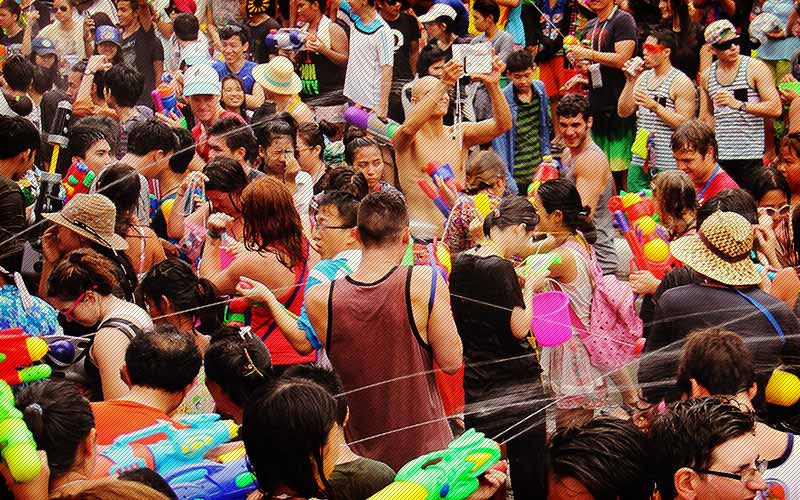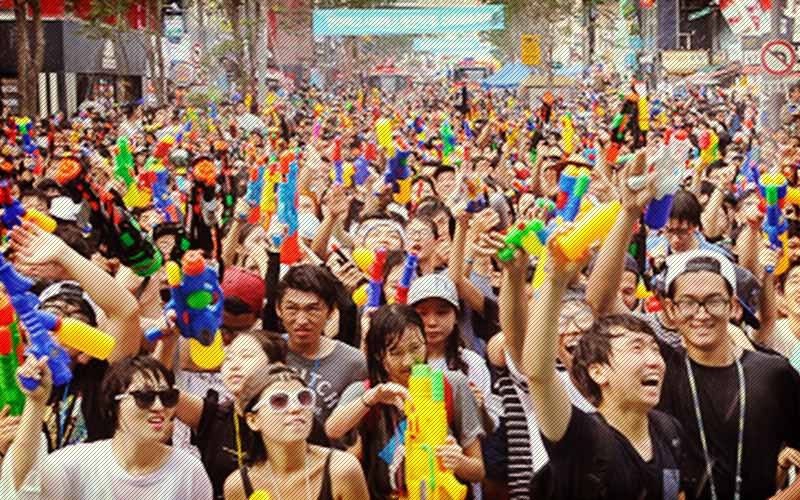Songkran marks the start of the new year in the solar calendar and the occasion is celebrated across the country in various ways, most of which have deep symbolic meaning. The event is richly traditional and well worth witnessing during a volunteer vacation to Thailand.
Although the whole nation celebrates, the festivities vary slightly depending on the region.
There are a number of traditions that are common across the country, however – keep reading to find out more about how Thailand celebrates Songkran and prepare for a memorable event when you volunteer in Thailand.

Water fights
The new year is famously marked by day-long water fights, which can be great fun for locals and visitors alike. There is some symbolism behind these water fights that many holidaymakers and tourists are not aware of, however.
At Songkran, water is used to douse people in the streets – this represents the symbolic washing away of bad luck and sin, purifying the person and providing a chance for good luck to prevail in the coming year. Water fights take place across the country, sometimes for a day, sometimes for longer, depending on where you visit when you’re volunteering in Thailand.
As you explore the streets of your destination during Songkran, you’ll come across people with buckets, water pistols and special spray cans, waiting for any chance to soak passers-by – you can join in in the fun too, just make sure you’re suitably dressed! In cities like Bangkok, water can be bought from street sellers and accessed via fire trucks dotted around the busiest parts of the city.
Colorful parades
Songkran is one of the best-loved festivals in Thailand and, as such, locals go all out to mark the occasion. Colorful parades are one such way of making the event all the more memorable, and you’ll see people and animals dressed in bright colors marching through the streets during the festival.
In many places, elephants and riders process through the town, painted and adorned to mark the momentous celebration, and cars are decorated with traditional symbols of Buddha, dragons, fish and other animal elements to be judged as part of local contests.
In Bangkok and the larger cities and towns, pageant parades are also organized, where local ladies dress in traditional clothing and take part in the Miss Songkran contest, where a winner is crowned based on her beauty and talents.
Paying respects
Thai people are generally very respectful, in-keeping with the dominant Buddhist beliefs of the nation. During Songkran, many residents can be seen paying their respects within the community.
Merit making is an important part of the Songkran festivities and is observed in a number of ways, such as by visiting the temple to pray and meditate, by offering food to the local monks and by spending time with family and loved ones.
Other ways of making merit practiced at Songkran include the release of caged or captive animals like birds and fish, and pouring water over statues of Buddha. Younger people often pour water over the hands of their elderly relatives and pay respects to their ancestors during this special time.
The best of the rest
During Songkran, there are all sorts of things to see and do. Food fairs commonly take place and these are ideal for sampling a wide range of Thai food as part of the celebrations. In the northern regions, meanwhile, you’ll come across fireworks and lots of loud bangs as residents repel bad luck with firecrackers.
Local schools often organize traditional dancing displays, which are put on in the streets for everyone to enjoy, and in the district of Phra Pradaeng it’s possible to enjoy watching a wide range of cultural activities, including boat races and flag ceremonies.
On the first day of Songkran, you can witness the Buddha image being brought out of the National Museum and carried through the streets, where locals sprinkle the statue with water. Throughout Bangkok, people also create sand stupas and decorate them with flags and flowers, especially within historic Rattanakosin.

Enjoy Songkran wisely
If you’ll be volunteering in Thailand during the Sonkran Festival, you’re sure to enjoy the fun and festivities, which can go on for days in the big cities and towns. To get the most from your experience, it’s wise to know a little about Thai culture and expectations before you start getting involved in the celebrations.
As a nation that respects modesty, Thai people have a high standard of decency when it comes to dress. As such, it’s not acceptable to wear overly revealing clothes, such as spaghetti strap tops and very short skirts. Although everybody gets wet during Songkran, it’s still recommended to observe local standards of decency by dressing appropriately. Light cotton clothes dry off quickly but provide enough coverage to protect your modesty.
It’s also worth remembering that Songkran is more than a day-long water fight, it has rich Buddhist origins that are meaningful in Thailand. Visitors should take care when getting involved in the water fights not to disrespect locals by pouring water too heavily over Buddha icons or dousing elderly people.
Top tips:
- - Arrive early to avoid the tailbacks – many roads are closed during Songkran to accommodate street parties and parades
- - Bring a light waterproof jacket if you don’t want your clothes to be soaked through!
- - Remember to be respectful of others by dressing modestly and pouring water lightly over Buddhist icons
- - Store your belongings in a waterproof bag to avoid water damage
- - Don’t throw water over motorcyclists or people riding bicycles to avoid causing accidents
Find out more about what you can see and do when you volunteer in Thailand by downloading our program brochure today!
